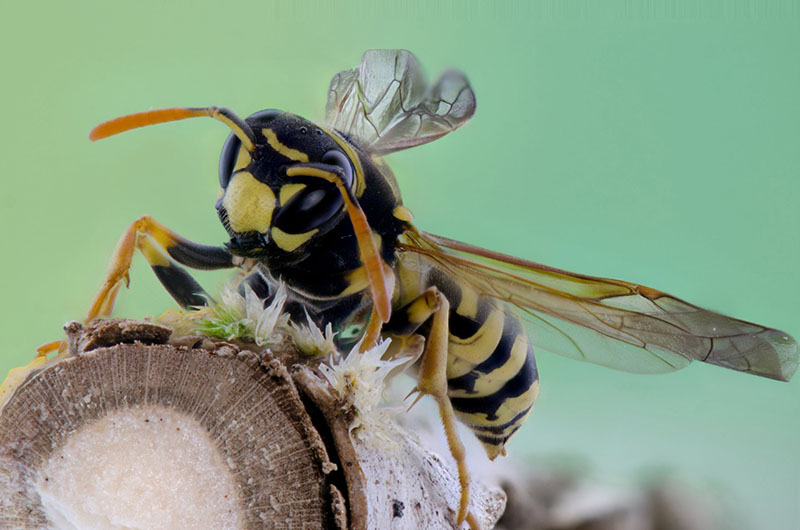Wasps and hornets can be quite the pests during the summertime in Minnesota. In fact, they can ruin what would otherwise be an enjoyable day outdoors, like a barbecue. Nobody wants to get stung! While pests like mosquitoes are annoying and potentially itchy, wasps and hornets can actually cause pain.
That’s why we want to get rid of them as soon as possible. Don’t let a hornet’s nest ruin your spring and summer. It’s time to learn how you can repel these pests and keep your outdoor spaces free of wasps and hornets in Minneapolis.
Types Of Wasps & Hornets
The first step in eliminating the threat of wasps and hornets is understanding them. You need to learn more about the various pest types in our state and how to deal with them. Certain wasps and hornets are far more of a problem than others. Trust us on that one!
Here are a few common wasp and hornet types in Minnesota and a few ways to identify them:
Paper Wasps
- Construct only one comb
- Shape of their nest is an umbrella
- Typically build their nest on horizontal beams
Yellow Jackets & Bald-Faced Hornets
- Capture other insects like spiders and arthropods and feed them to their young
- Adults feed primarily on sources of sugar like juices and ripening or overripe fruit
- Feed on the nectar of flowers
Now, this may help you identify whether you’re dealing with a wasp, yellow jacket, or bald-faced hornet. However, we typically recommend most homeowners avoid dealing with these pests alone, as nobody wants to get stung by a wasp. It hurts!
Wasp & Hornet Nesting: What You Need to Know
Paying attention to the nesting habits of wasps and hornets can usually determine what type of pest you’re dealing with and the best course of action. It’s fairly easy to tell the difference between these pests and how they nest.
For example, here are a few facts and items we pay attention to before removing a pest nest from your home and property:
- Wasps make nests from chewed up papery wood fibers with mixed saliva. Nests are usually combs surrounded with an envelope of several layers.
- Yellow Jackets commonly build their nests below ground or in cavities or old rodent burrows, hollow longs, landscape timbers and buildings in attics or wall voids.
- Bald faced hornets build aerial nests out in the open in trees or under the eaves of buildings.
Nests are used for just one season and not re-occupied the next season. This is good news for your property, as the pests are not instinctively programmed to come back to your property year after year. If you properly removed the pests and their nests, you can get rid of wasps and hornets for good!
Life Cycle of Wasps & Hornets
To further understand these pests and how they operate, it’s important to note that all wasps and hornets have a complete life cycle. The cycle goes from egg to larva to pupa, and then adulthood. When understanding wasps and hornets, you’ll also want to pay attention to these few facts:
- Colonies only survive one year and are referred to as an annual colony.
- Queens are the only members of the colony that survive the winter.
- Newly produced and mated queens leave old nests and search for protected sites to overwinter: under loose bark, rotten stumps, and under siding.
In the early spring, a queen will begin to find a place to start her new nest. She’ll find the nest, lay eggs, and then begin raising the workers, sterile female offspring. Each nest can have one queen or multiple. It just depends. This tends to happen around April each year in Minnesota.
By late summer and fall, the nests have produced new queens. The colonies begin getting smaller in size, as queens stop laying eggs at this time. While no new eggs are being laid, the nests continue to be active places. Most nests start to die down once freezing temperatures hit consistently.
How To Stop Attracting Wasps & Hornets: Prevention Methods
There’s a good reason everyone wants to prevent wasps and hornets from making their property home. It’s because these creatures are truly pests and not pleasant to be around. Overall, the absolute best strategy to deal with these bad guys is to minimize attracting them as best as you can.
To stop attracting wasps and hornets, you need to do a few things. Here’s our list of wasp and hornet prevention methods:
- Keep Food Contained: Wait to serve food and drink until people are ready to eat. Don’t place open containers of food out before it’s time to eat, especially when having guests over or a barbecue.
- Clean Up Properly: Never leave food out in the open once you’ve eaten. Immediately package food into a container or throw it away in a trash can with a tight-fitting lid. The less exposure to pests your food has, the better chance pests don’t stick around.
- Ignore Them: If you’re dealing with a yellow jacket that has flown into your drink or food, it may be best to simply ignore the pest until they leave. You don’t want to aggravate these guys. You can also try catching them with a net and crushing them if they’re bothering you. Swiping at them with your hands is worthless and can make the situation worse.
- Wasps Problems: While you can use traps to catch some wasps, they simply won’t be enough during the end of summer and early fall when wasps are at their greatest numbers. If you’re having a wasp problem, professional help is often the best course of action. This is especially true in the spring and early summer months, as the issue will just continue to get worse throughout the summer and into fall.
The less trash and food you leave out, the better chance you have of curtailing a wasp and/or hornet problem. These pests are attracted to food and drink. If there’s none around, they’ll be forced to find it elsewhere. When that happens, the pests leave your property and become someone else’s problem – which is what we want.
Wasps & Hornets In Minnesota: Everything You Need to Know
Sometimes natural ways to get rid of pests simply aren’t possible. You might make it impossible for these pests to find drink and food around your place, but their nest is already on your property and the neighbors all leave food out. They have no reason to pack up shop because they have a home and food.
While that’s great for the pests, it’s certainly not ideal for any homeowner dealing a nest and/or colony. In fact, it can be a disaster. No one wants to spend the warm summer months inside because your backyard is a breeding ground for terrorizing pests that won’t let you unwind in peace.
Luckily, there’s a simple solution in Minneapolis and the surrounding areas. At Abra Kadabra, we’re here to handle all your pests problems in the Twin Cities.
Wasp & Hornet Removal In Twin Cities, MN
To learn more about wasp and hornet removal and exclusion services for your home, community association or business, contact the experts at Abra Kadabra Environmental Services at (763) 537-0330. Our pest control technicians will gladly answer any questions and have you on your way to a pest-free summer!







